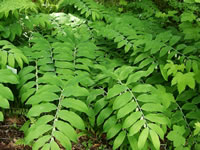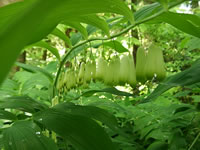How to Grow and Care for Solomon's Seal Plants
Polygonatum multiflorum
     
|

|
The Solomon's Seal, Polygonatum multiflorum is a shade loving, deciduous perennial that produces large, slow spreading clumps of arching, three feet stems lined with pairs of bright green leaves.
In late spring, clusters of 2-5 elongated bell shaped, greenish-white flowers will hang beneath each pair of leaves.
Growing Requirements for Solomon's Seal Plants
Solomon's Seals are hardy in USDA zones 5-9, but grow best in cooler climates.
They grow best in partial shade, but can be grown in deep shade as well as in partial sun.
They should be planted in a compost rich, constantly moist, acidic soil with a pH of 5.0-7.0.
|
|
Solomon's Seal plants are an excellent choice for woodland or shade gardens and for using as background plantings with hardy ferns.
They look great when planted in large containers!
Solomon's Seal plants are usually grown from rhizomes which should be planted 2 inches deep in the Spring or Fall.
Propagating Polygonatum Plants
Once established, Solomon's Seals will spread by rhizomes as well as by reseeding themselves.
Seed grown plants will take as long as four years to reach blooming size, so you are better off to transplant 'volunteer' seedlings or propagate new plants by dividing established clumps in the early spring. |
|
Solomon's Seal
Polygonatum multiflorum
 |
 |
|
|
|
Search The Garden Helper: